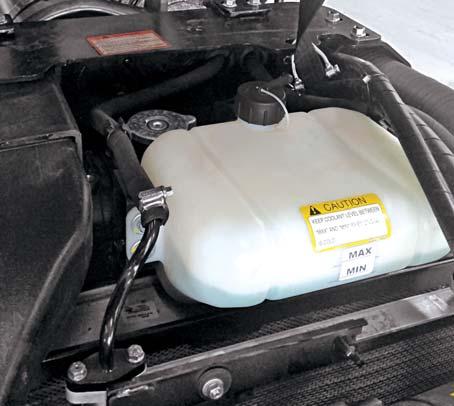
5 minute read
Do's & Dont's
from Mahindra Tractor‘8000’ Series 8090 8100 4WD CABIN TIER-4 FINAL Operator's Manual - PDF DOWNLOAD
DO’S - For Better Performance
•Ensure that all safety shields are in place and in good condition.
•Read all operating instructions before commencing to operate tractor.
•Ensure all lights are in 'OFF' position before starting the tractor.
•Carry out all maintenance tasks without fail.
•Keep the air cleaner clean.
•Ensure that the correct grade of lubricating oils are used and that they are replenished and changed at the recommended intervals.
•Watch the oil pressure warning light and investigate any abnormality immediately.
•Keep the radiator filled with clean anti-freeze mixture. Drain the system only in an emergency and fill before starting the engine.
•Ensure that the transmission is in neutral before starting the engine.
•Keep all fuel in clean storage and use a filter when filling the tank.
•Attend to minor adjustments and repairs as soon as necessity is apparent.
•Allow the engine to cool before removing the radiator cap and remove the radiator cap slowly.
•Shift into low gear when driving down steep hills.
•Latch the brake pedals together when driving on a highway.
•Keep draft control lever and position control lever fully down when not in use.
•Visit Dealer for adjustment on Injector pressure. Adjust if required.
•Slow down the engine speed before shifting the F-R shuttle switch.
•Keep the auxiliary valve levers in neutral (N) when not in use.
•Replace both clutch and brake cables after 1000 hours of tractor operation.
•Idle the engine for 1 to 2 minutes after starting and before stopping the engine.
DONT’S - For Safe Operation
•Do not run the engine without the air cleaner.
•Do not start the tractor in high idle.
•Do not start the tractor in an enclosed building unless the doors and windows are open for proper ventilation.
•Do not operate the tractor or engine while lubricating or cleaning.
•Do not allow the tractor to run out of diesel fuel otherwise it will be necessary to bleed the system.
•Do not tamper with fuel, EGR, SCR or any other emission systems. It may cause engine to derate as per legal inducement requirements since it may affect emissions.
•Do not allow the engine to run idle for a long period.
•Do not run the engine if it is not firing on all cylinders.
•Do not ride the brake or clutch pedal. This will result in excessive wear of the brake linings, clutch driven member and clutch release bearing.
•Do not use the independent brakes for making turns on the highway or at high speeds.
•Do not refuel the tractor with the engine running.
•Do not use draft control lever for lifting of implements.
•Do not start the engine with the P.T.O. engaged.
•Do not use the hand throttle while driving on roads.
•Do not run cold engine at full throttle.
•Do not run the tractor on road with 4WD engaged above 10 mph.
•Do not operate F-R shuttle switch while tractor is in motion beyond 6.2 mph speed.
•Do not operate the power steering when the oil level is below the minimum level in the reservoir.
•Do not run the tractor if the power steering system is damaged. In this condition, contact the Dealer.
•Do not park the tractor on a gradient with transmission gear engaged and with no parking brake.
•Do not operate the wipers on dry windshield, it may scratch the glass.
DO’S - For Sensors
•Check for any dust entry, terminal corrosion and breakage of terminals.
•Check for water entry in the connectors.
•Ensure the connectors are properly connected. Any unused pin in the counter-connector should be blocked.
•Connector cable has to be secured to the bracket provided with cable tie.
DONT’S - For Sensors
•Do not damage the tip of the sensor during mounting.
•Do not use striking tools like hammer/ drop the sensor on the floor.
•Make sure that no particles are inside the electrical connectors & sensors before connecting the plug.
•Please do not try to open the cover of the connector with a screwdriver.
•Do not wrap the cable tight around the electronic unit.
•Do not pull at connector cable while removing connector.
•Do not knot the cable of connector/sensor.
•Do not carry the sensor by holding the connector cable.
•Do not use the Automated torque wrenches.
•Do not drop any sensor.
•The sensor harness should not touch any hot surface of vehicle.
•Avoid short-circuit with battery terminals to avoid flow of high current to ECU.
Engine Cooling System
The engine cooling system consists of :
A.Radiator
B.Surge Tank
C.Fan
D.Thermostat
E.Water Pump
F.Fan Belt
G.Hoses & Connections
To ensure an even temperature within the engine, the cylinder head and cylinder walls of the engine are water cooled. This water is in turn cooled in the radiator. The water is circulated from the radiator to the engine and back through the radiator by means of a water pump.
Radiator
The radiator consists of a cluster of hollow tubes enshrined into a number of fins and enclosed at both ends vide a Top Tank and a bottom tank.
Air sucked by Fan passes through the radiator fins thereby cooling the coolant flowing through radiator tubes. The fins should be kept clear of mud or dirt accumulation. Over heating may be caused by bent or clogged radiator fins. If the spaces between the radiator fins become clogged, clean them with compressed air or coolant blown from engine side.
Radiator Cap
A pressurised radiator cap is provided which is set at 13 psi (0.9 kg/cm2) pressure. This cap ensures better cooling and avoids loss of coolant due to evaporation. It also reduces corrosion in engine sleeve & crankcase, hence it is strongly recommended that the engine should not be run without radiator cap. Also ensure that rubber gasket is intact & perfectly sealing the system pressure.
Surge Tank
When the engine is in operation, certain amount of coolant passes out of the radiator overflow pipe. This coolant is not allowed to escape into the atmosphere and captured into a Surge tank.
When the engine is not operating and the coolant cools down, certain amount of coolant comes back into the radiator from surge tank. The surge tank thus helps to prevent loss of coolant.
Thermostat
This device prevents coolant circulating through the radiator until the engine reaches its operating temperature. With the thermostat closed, the coolant circulates only through the engine block.
It is important that if the thermostat is defective, do not attempt to repair it, replace with new. When installing a new thermostat, ensure the valve is facing upward.
Thermostat starts open at 68°C to 72°C and fully open at 84°C max.
When straightening bent fins be careful not to damage the tubes or to break the bond between the fins and tubes.
The cooling system operates under pressure. It is dangerous to remove the radiator cap while the system is hot.
Always turn the cap slowly to the first stop, and allow pressure to escape before removing the cap completely.
Do not run the engine when the cooling system is empty, and do not add cold coolant or cold antifreeze solution if the engine is hot.
The coolant level in surge tank should be maintained between the MIN and MAX level mark.
Do not run the Engine without Thermostat Valve.








